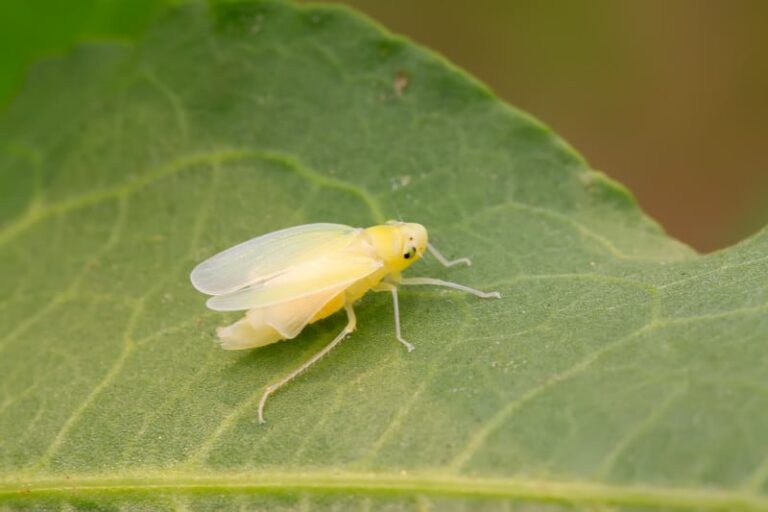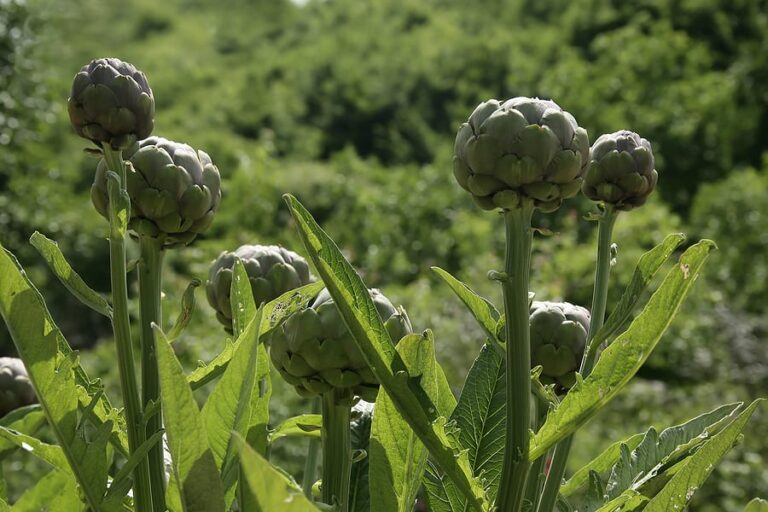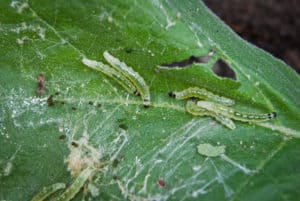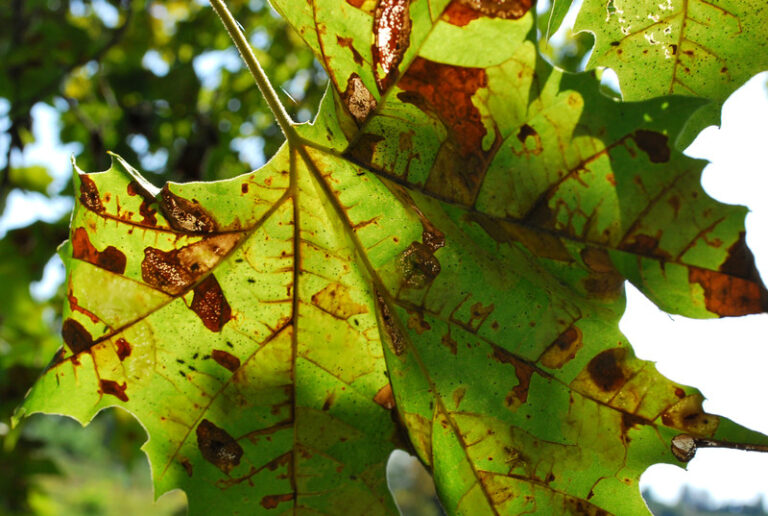Cabbage Growing Problems: Troubleshooting
Grow cabbage as rapidly as possible. Give cabbage plenty of moisture and be sure to feed it through the season–a planting bed amended with aged compost and side dressings of compost tea every two weeks will do the job.
Cabbage can be grown in three distinct crops: early, mid-season, and late. Early cabbage can be wintered over in cold frames from seed started the preceding fall (or sow early cabbage in hotbeds in late winter and transplanted in early spring). Midseason cabbage may be sown in the cold frame for 6 weeks before transplanting into the garden after the last frost in spring. Late varieties may be sown in early summer directly in the garden where they are to mature.
While cabbage is hardy at maturity, young plants should not be subjected to frost.
Here are common cabbage-growing problems with cures and controls:
Seed and seedling problems
Seedlings fail to emerge from soil; seedlings are eaten; roots are tunneled
A cabbage maggot is a small gray-white, legless worm to ⅓-inch long; an adult is the cabbage root fly, which looks like a housefly. Flies lay eggs in the soil near the seedling or plant. Maggots will tunnel into roots leaving brown scars; some plants may be honeycombed with slimy tunnels. Exclude flies with floating row covers. Remove and dispose of damaged plants. Apply lime or wood ashes around the base of plants; time planting to avoid insect growth cycle. Plant a bit later when the weather is drier. Companion plant with mint.
Seeds rot or seedlings collapse with dark water-soaked stems as soon as they appear
Damping off is a fungus that lives in the soil, particularly where humidity is high. Do not plant in cold, moist soil. Make sure the soil is well drained.
Seedlings are eaten or cut off near the soil level
Cutworms are gray grubs ½- to ¾-inch long that can be found curled under the soil. They chew stems, roots, and leaves. Place a 3-inch paper collar around the stem of the plant. Keep the garden free of weeds; sprinkle wood ash around the base of plants.
Young sprouts fail to grow or die back; bluish-black spot on leaves and stems
Blackleg is a fungal disease that leaves sprouts girdled and rotting at soil level–“blacklegs.” Blackleg is spread by cutworms and cabbage maggots. Remove and destroy infected plants; keep the garden free of plant debris. Add organic matter to the planting bed; make sure the soil is well-drained. Rotate crops.
Tiny shot holes in the leaves of seedlings
Flea beetles are tiny bronze or black beetles a sixteenth of an inch long. They eat small holes in the leaves of seedlings and small transplants. The larvae feed on the roots of germinating plants. Spread diatomaceous earth around seedlings. Handpick off plants, Cultivate around plants often to disrupt the beetles’ life cycle. Keep the garden clean. Spade garden soil deeply to destroy larvae in early spring. Treat plants with Sevin, pyrethrum, or rotenone.
Young plants flower
Cold will cause young plants to flower and produce seeds without forming a head. Protect young plants from cold weather with floating row covers; set transplants into the garden no sooner than 1 to 3 weeks before the last average frost date in spring.
Leaf problems
Irregular yellowish to brownish spots on upper leaf surfaces; grayish powder or mold on undersides
Downy mildew is caused by a fungus. Improve air circulation. Plant disease-resistant varieties. Rotate crops. Keep the garden free of plant debris.
Leaves become dull yellow, curl, and the plant may die
Cabbage yellows is caused by the Fusarium soil fungus that infects plants usually where the soil is warm. The disease is spread by leafhoppers. Remove infected plants. Control leafhopper. Keep the garden free of weeds which can harbor disease. Keep soil evenly moist, but not wet. Rotate crops. Plant disease-resistant varieties: Early Snowball.
Leaves yellow; plant stunted; small glistening white specks on roots
Cyst nematode is a microscopic worm-like animal that lives in the film of water that coats soil particles. Rotate cabbage family crops. Solarize the soil with clear plastic in mid-summer.
Leaves are yellowish and slightly curled with small shiny specks
Aphids are tiny, oval, whitish-green, pink, or black pear-shaped insects that colonize on leaves. They leave behind sticky excrement called honeydew which can turn into a black sooty mold. Remove with a blast of water. Use insecticidal soap solution. Mulch with aluminum foil to disorient aphids.
Leaves have whitish or yellowish spots; leaves are deformed; plant wilts
Harlequin bugs or stink bugs. Harlequins are black with bright red yellow or orange markings. They suck fluids from plant tissue causing white and yellow blotches. Handpick and destroy bugs and egg masses. Keep the garden free of crop residue and weeds where bugs breed. Spray plants with Sevin, pyrethrum, and rotenone. Stink bugs are gray or green shield-shaped bugs about ¼-inch long; they feed on fruits. Remove garden debris and weeds where bugs can overwinter. Hand-pick egg masses and bugs and destroy them.
Leaves partially eaten; leaves webbed together; eggs in rows on undersides of leaves
Cabbage webworms are green with a light stripe to ¾ inches long; the webworm is the larvae of a brownish-yellow moth with gray markings. Larvae spin light webs. Clip off and destroy webbed leaves. Destroy caterpillars. Keep garden weed free.
Leaves are eaten and plants are partially defoliated
Blister beetles are slender gray or metallic black beetles to ¾-inch long; they may have striped spots on their wings. Handpick beetles and destroy them. Keep the garden weeds and debris. Cultivate in spring to kill larvae and interrupt the life cycle. Spray or dust with Sevin or use a pyrethrum or rotenone spray.
Small holes in leaves; loose cocoons about ⅓-inch long on leaves
Pale green caterpillar is the larvae of the gray diamondback moth. Moth has yellow diamondback shapes on folded wings. Keep the garden free of weeds, particularly mustard plants. Handpick and destroy caterpillars. Spray with Bacillus thuringiensis is very effective.
Large holes in leaves; leaves skeletonized
Cabbage loopers or armyworms. (1) Cabbage looper is a light green caterpillar with yellow stripes running down the back; it loops as it walks. Keep the garden clean of debris where adult brownish night-flying moths can lay eggs. Cover plants with spun polyester to exclude moths. Pick loppers off by hand. Use Bacillus thuringiensis. Dust with Sevin or rotenone. (2) Armyworms are dark green caterpillars the larvae of a mottled gray moth with a wingspan of 1½ inches. Armyworms mass and eat leaves stems, and roots of many crops. Armyworms will live inside webs on leaves. Handpick caterpillars and destroy them. Cultivate after harvest to expose the pupae. Use commercial traps with floral lures.
Leaves are chewed and slimed
Snails and slugs eat leaves. Collect these pests at night. Set beer traps at soil level to attract and drown snails and slugs.
Leaves chewed; tunnels inside cabbage and cauliflower heads
Imported cabbage worm is a pale green caterpillar with yellow stripes to about 1¼ inches long; the adult is a white moth with two or three black spots on the forewing. Use Bacillus thuringiensis. Destroy all remains and weeds after harvest. Companion plant with mint. Encourage the predatory Trichogramma wasp.
Browning along margins of old leaves; water spots at the core of plant; leaves are bitter and tough
Boron deficiency is often found in alkaline soils. Test soil. If deficient, add 2 ounces of borax per 30 square yards. Plant disease-resistant varieties: Plant Wisconsin Ballhead, Wisconsin Hollander No. 8.
Leaves and head become pale green; leaves wilt; slimy rot develops in stem, leaves, and head
Bacterial soft rot is caused by Erwinia bacteria. Water-soaked spots appear on leaves and roots; spots enlarge and turn dark and mushy. Black ooze develops in cracks in roots and stems. Rot can not be cured. Collect and burn infected plants Promote good drainage by adding aged compost and organic materials to planting beds. Avoid overhead watering. Rotate crops.
Leaves are pitted
Blowing soil particles can pit leaves and cause wart-like projections the size of a pinhead. Protect plants from blowing soil and sand with floating row covers or use windbreaks in large gardens.
Margins of internal leaves turn brown
Tipburn is caused when leaves do not take up enough water. This can happen if there is a calcium deficiency in the soil. Test soil. Maintain consistent and even soil moisture. Mulch and cultivate only shallowly during drought. The soil pH should be between 6.0 and 7.0, add limestone which contains calcium if the pH is below 6.0.
Whole plant problems
Plant wilts; roots are swollen and misshapen, roots rot
Clubroot is a soilborne fungal disease. Fungus interferes with water and nutrient uptake of roots. Keep the garden clean of plant debris and weeds that can harbor the fungus. Remove and destroy infected plants including soil around roots. Clubroot is found in acid soils; add lime if the soil pH is below 7.2. Rotate crops for at least 2 years. Purchase transplants from disease-free suppliers.
Plant stunted; worms tunnel into roots
Plump grayish grub with a brown head is the larva of the June beetle, a reddish brown or black hard-shelled beetle to 1 inch long. Wireworms are the soil-dwelling larvae of click beetles; they look like wiry-jointed worms. Check the soil before planting; handpick and destroy pests; flood the soil if wireworms are present. Remove infested plants and surrounding soil. Keep the garden free of refuse that could shelter beetle eggs.
Main stem becomes dark and wiry
Wirestem is caused by the Rhizoctonia fungus which also caused damping off. Infected plants will not produce strong heads. Do not plant in cold, moist soil. Make sure the soil is well drained.
Bolting; plants flower and go to seed
Cabbage will bolt prematurely if plants are exposed to 20 or more days with temperatures below 50°F; this can happen with cabbage planted to over winter. Protect young plants from cold; use horticultural cloth or cloches when temperatures are low. Don’t plant too early.
Head problems
Plants do not set heads or the heading is poor
Overcrowding or dry soil. Give cabbage plenty of room to spread out; this will aid heading. Keep plants evenly moist.
Heads split and crack
Too much water; too much nitrogen. Keep plants evenly moist; avoid wetting and drying soil. Do not overwater. If plants go dry, apply water slowly at first. Prune roots to slow the uptake of water and slow growth; do this by turning the head a half turn to break off some of the roots and slow growth. Feed plants will aged compost; avoid nitrogen-rich fertilizers. Harvest plants when they are mature; do not allow them to sit too long in the garden.
Cabbage growing success tips
Planting
Grow cabbage in full sun in cool weather. Plant cabbage in well-drained soil that is rich in organic matter. Add aged compost to the planting bed in advance of planting. Cabbage is most easily grown from transplants which are better able to withstand pests and disease. For small heads, space cabbage about 12 inches apart and harvest as soon as heads are the size of a softball. For larger heads, space plants from 18 to 24 inches apart.
Planting time
Cabbage is a cool-weather crop that grows best in spring and fall, when temperatures average between 60° and 70°F. Cabbage grows best when it comes to maturity in cool weather; however, long periods of temperatures below 50°F will cause the cabbage to flower and go to seed. Grow cabbage in summer in cool-summer regions and in winter in mild-winter regions. Start cabbage indoors as early as 7 to 9 weeks before the last average frost date in spring; set transplants into the garden 1 to 3 weeks before the average last frost date. For a fall crop, set cabbage transplants in the garden 6 weeks before the first average frost date in fall; sow seed for a fall crop 12 weeks before the first hard frost.
Care
Keep cabbage evenly moist. Avoid allowing the soil to dry out; dry and wet and dry and wet periods will cause cabbage heads to either not grow well or to split and crack. Side-dress cabbage with compost tea as soon as heads start to form; cabbage requires a steady supply of nitrogen. Rotate cabbage family crops on a regular basis; cabbage family crops share many of the same soilborne diseases. Use floating row covers to keep cabbage pests away from crops early in the growing season.
Harvest
Cabbage is ready for harvest as soon as heads are about the size of a softball and firm. A firm head to ready for harvest. Leafy cabbage such as napa cabbages and Asian cabbages can be cut when leaves are about 12 inches tall.
Cabbage Learning Hub
🥬 Start Here: The Ultimate Cabbage Growing Guide: From Seed to Harvest
🌿 Planting & Timing
- Cabbage Seed Starting Tips
- When to Plant Cabbage: Timing for Spring, Summer, and Fall Crops
Covers zone-based timing, transplant vs. direct sow. - How to Grow Spring Cabbage for Early Harvests
“Spring cabbage growing” – high seasonal interest. - How to Grow Cabbage in Containers: A Complete Guide
Perfect for urban/small-space gardeners. Include spacing, soil depth, and feeding. - How to Space and Thin Cabbage for Tight, Heavy Heads
Spacing is a common problem leading to poor heads or bolting.
How to Plant, Grow, and Harvest Chinese Cabbage
🦟 Pests, Diseases & Troubleshooting
- Common Cabbage Pests and How to Get Rid of Them Naturally
Aphids, cabbage worms, flea beetles, cutworms. - Why Is My Cabbage Splitting? Causes and Fixes for Cracked Heads
Very specific problem; here’s why this happens. - How to Prevent Bolting in Cabbage and Other Brassicas
Seasonal temperature swings confuse many gardeners.
💧 Care & Growing Tips
- How Much Water Does Cabbage Need? A Seasonal Watering Guide
“How often to water cabbage” queries are common. - How to Fertilize Cabbage for Leaf Growth and Head Formation
Discuss starter fertilizer, side-dressing, nitrogen balance.
What to plant with cabbage. - Common Cabbage Pests and Diseases and How to Treat Them Naturally
🧊 Harvesting, Storage & Preservation
- How to Harvest and Store Cabbage
- How and When to Harvest Cabbage for Peak Flavor and Texture
Includes signs of readiness and how to cut heads without damagin - Best Companion Plants for Cabbage (And What to Avoid)g the plant.
🥗 In the Kitchen & Beyond
- Seven Ways to Cook and Serve Cabbage
- Five Ways to Cook and Serve Chinese Cabbage
- Four Ways to Cook and Serve Napa Cabbage
🌱 Varieties & Seed Saving
- Best Cabbage Varieties for Your Climate and Growing Zone
Optimized for zone-specific growing.
- Savoy, Napa, and Red: Which Type of Cabbage Should You Grow?
Comparative format — helpful for new gardeners. - Growing Green Cabbage vs. Red Cabbage: The Differences
- Oriental Mustard Cabbage Explained: White Stalks vs. Green Stalks
Cabbage articles at Harvest to Table:
How to Harvest and Store Cabbage
Cabbage Growing Problems Troubleshooting
Imported Cabbage Worm Organic Pest Control
Cabbage Looper Organic Pest Control
Seven Ways to Cook and Serve Cabbage
Sliced Cabbage Salad Simply Made
Corn Beef and Cabbage Slow Cooked
How to Make Cabbage Soup with No Recipe
Savory Raddish-Cabbage Coleslaw
Related articles:
Vegetable Garden Diseases Problem Solver
Vegetable Garden Organic Weed Control
Garden Planning Books at Amazon:







